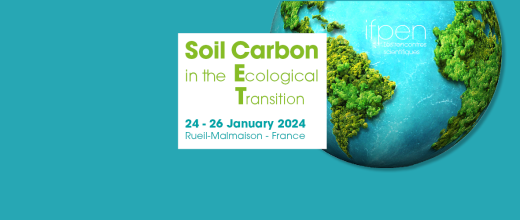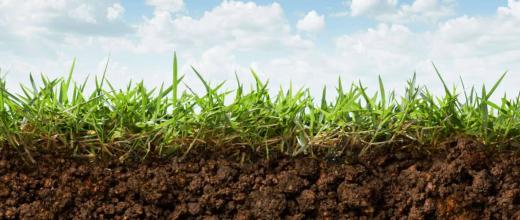Soils store carbon in the form of organic matter and release it as gas into the atmosphere, primarily in the form of CO2. When they store more than they release, they act as so-called “carbon sinks“. Therefore, soils can play a role in climate change mitigation strategies. Europe, spearheaded by France with its Low-Carbon label, encourages agricultural and forestry strategies promoting carbon storage in soils.
Soils, an important carbon reservoir for the planet
What is a carbon sink?
How is carbon stored in soils?
Evaluating and monitoring carbon in soils
Soils, an important carbon reservoir for the planet
Globally, 5 billion metric tons of carbon are released every year, to add to the 800 billion tons of carbon already contained in the atmosphere.
The IPCC report points to the need for an immediate reduction in greenhouse gas emissions. Alongside renewable energies and less energy-intensive technologies figure other solutions for reducing the quantities of CO2 in the atmosphere: reforestation, carbon storage in long-life materials, CO2 storage in geological reservoirs and carbon sequestration in soils.
>> Check out IFPEN’s podcasts on CCUS in the ecological transition
The most recent studies estimate that 1,500 billion tons of global carbon reserves are contained in the upper one-meter layer of soils. These figures make soils the planet’s biggest carbon reservoir, after the hydrosphere (oceans, seas, lakes, rivers). It is twice the amount of carbon contained in the atmosphere and three times that contained in vegetation.
Soils, carbon and organic matter, just what are we talking about?
Soils are made up of mineral matter (rock debris such as silt, sand and clay), and organic matter (OM), defined as “anything that is either living or has lived“. This organic matter is itself made up of 50% carbon.
What is a carbon sink?
The variation in the amount of organic matter contained in soils depend on two types of flows:
- inputs into the soil in “fresh“ form, made up of litter with leaves, twigs, dead roots, dead microorganisms, crop residues, organic fertilization, etc.
- outputs in gas form: decomposed and mineralized by decomposer organisms (mushrooms, bacteria, earth worms, etc.), OM is converted into gas molecules (CO2, N20 and CH4) and released into the atmosphere.
Soils thus represent a double-edged sword: on the one hand, they are capable of storing carbon and therefore represent a fundamental lever to be incorporated into climate change mitigation strategies, and, on the other hand, they can be a source of greenhouse gas emissions (CO2, but also methane (CH4) in some instances), since climate change and rising temperatures tend to increase soil organic matter decomposition and, consequently, the release of carbon into the atmosphere.
A study conducted by a multidisciplinary team at IFPEN, coordinated by Leeds University and published in the Nature journal clearly establishes the link between global warming and peat decomposition in the Central Congo Basin between 5,000 and 2,000 cal BP, causing significant amounts of carbon to be released into the atmosphere.
One of the study’s conclusions asserts that were an identical scenario to reoccur in the future, such a release of carbon would only further accelerate the climate change already underway.
>> See the study
When soils store more CO2 than they release, they act as so-called “carbon sinks“. Plants, some aquatic ecosystems, underground environments and long-life materials can also act as carbon sinks.
How is carbon stored in soils?
While carbon storage occurs at about the same speed as its degradation in savannah regions and tropical forests, this is not the case for agro-ecosystems where this balance is threatened by human activities.
Change in land use (a grassland is planted with crops or artificialization), evolving production methods, loss of cultivatable land and woodland due to urbanization and excessive or uncontrolled removal of biomass may affect soil quality and degrade carbon stocks.
In figures
Today, 25% of the planet’s soils are significantly degraded (41% for cultivated land), and this is increasing by 12 million hectares per year (source: OPECST).
It is therefore imperative to implement judicious soil management policies, firstly to increase their carbon sink capacities, and secondly to preserve and restore their quality with a view to sustainable agriculture.
Beyond climate… biodiversity and food security challenges
The organic matter (OM) content of soils lies at the heart of agronomic and environmental challenges since it determines:
- Soil quality, upon which food security and the health of the population depend;
- Soil structure, which governs erosion and water retention;
- And soil biodiversity, which is vital for ecosystems and soil resilience.
Farmers, at the forefront of carbon management in soils
By increasing the amount of OM in soils or limiting losses, agricultural land management practices have a significant impact on carbon stocks.
Conservation agriculture, officially defined by the FAO (Food and Agriculture Organization) in 2001, places soil at the heart of the production system and is based on three main principles:
- Maximum soil coverage, via crop residues or cover crops,
- Direct application of seeds and/or fertilizer without tillage,
- Diversification of cultivated species via varied crop sequences and associations involving at least three different crops
Farmers are at the forefront of OM management in soils: they can increase OM content via conservation agriculture and soil inputs, i.e., practices involving the use of co-products and waste from different biomass conversion sectors (arable crops, livestock, biomaterials, energy) to fertilize and enrich soils.
Not forgetting: forest soils
Forest soils also need to be monitored: numerous potential storage practices can be deployed there (regular continuous cover forestry, staddling, minimization of soil tillage, smallwood management, deployment of drought-resistant species, etc.). In addition, the foreseeable increase in wood requirements for energy and material production in the coming years is likely to intensify forest harvesting. The impact of this intensification on soil carbon stocks is not clear.
Evaluating and monitoring carbon in soils
Generally speaking, soil evolution and its impact on organic matter are complex and little understood. Between peatlands, forestry land, agricultural land, degraded and artificialized land or land that has been made impermeable, the maximum quantity of OM a soil can contain as well as its rate of decomposition can vary significantly from one ecosystem to another.
In order to reduce this uncertainty, something that is essential for better soil management, we need to improve scientific knowledge in the field. Stemming from national research, soil analysis protocols now make it possible to accurately quantify and characterize OM in soils on the basis of several indicators.
>> Find out more about SoilCET, the international symposium organized by IFPEN
From the 4 per 1000 initiative to the Low-Carbon label: France at the forefront
France is one of the most proactive countries when it comes to soils. It spearheaded the “4 ‰ on soils for food security and the climate“ initiative at COP21 in 2015 to mobilize the international community around soil issues.
4 per 1000: a simple calculation
Total annual CO2 emissions due to human activities currently represent four one-thousandths of the carbon (C) stored by the planet’s soils. In other words, increasing agricultural soil organic matter by 4 g per 1,000 g of CO2 every year compensates for all of these emissions
In order to slow down land artificialization, the biodiversity plan introduced a “zero net artificialization” objective in 2018, aimed at changing urban development rules to promote urban renewal and habitat densification, as well as regreening of abandoned artificialized spaces (brownfield sites and commercial wastelands).
Artificialized land area the size of Luxembourg?
If nothing is done, 280,000 hectares of additional natural spaces with be artificialized by 2030, i.e., an area a little over the size of Luxembourg.
Lastly, in 2019, France launched the Low-Carbon label within the framework of the country’s National Low-Carbon Strategy (SNBC): a French government carbon offset project certification tool that is applied to different sectors, including agriculture.
Its objective: to encourage the development of low-carbon projects making it possible to reduce greenhouse gas emissions and increase carbon storage in soils.
How does it work ? Having collected data relating to the parcel concerned, simulation models establish a carbon footprint evaluating the maintenance and additional storage of carbon in soils associated with the different levers employed to increase carbon inputs: biomass returned by plant cover, crop residues, incorporation and extension of temporary and artificial grasslands in rotations, etc.
Once the evaluation has been completed, the Low-Carbon label allocates carbon credits to carbon offset project leaders, credits that are then re-sold on the carbon market to local authorities, companies and citizens seeking to offset their residual emissions.
Points to remember
Soils are among the planet’s biggest carbon reservoirs, after the hydrosphere. They contain twice the amount of carbon contained in the atmosphere and three times that of vegetation.
A climate change mitigation strategy applied to soils require judicious soil management in order to preserve and develop their carbon sink capacity.
Farmers are at the forefront of OM management in soils: agricultural practices can increase the stock of OM in soils or reduce losses.
Scientists are currently working to gain a better understanding of soil dynamics and their impact on organic matter within different ecosystems as a function of usages and practices. Reducing uncertainty regarding the complex mechanisms of multiple origins governing OM decomposition is imperative in order to develop a more informed soil management approach, firstly to preserve or restore its quality with a view to sustainable agriculture, and secondly to increase its carbon sink capacities.
Although the challenges surrounding soil in the context of climate were incorporated into the Kyoto protocol of 1997, a European framework directive on soil protection has yet to be adopted on a Europe-wide level.
With the launch of the “4 per 1000“ initiative and the creation of a Low-Carbon label fostering the promotion of virtuous agricultural practices on the carbon market, France is a pioneer in the field.







